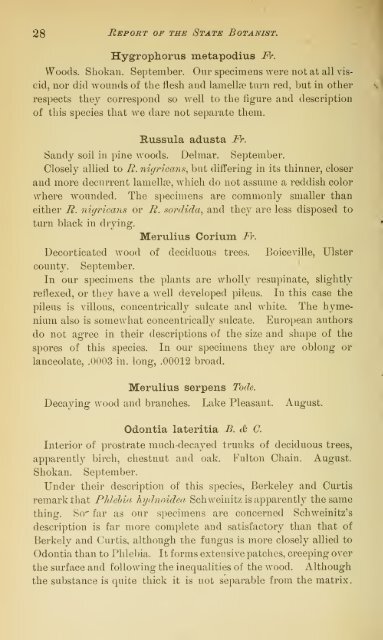Annual Report of the State Botanist 1892 - MykoWeb
Annual Report of the State Botanist 1892 - MykoWeb
Annual Report of the State Botanist 1892 - MykoWeb
You also want an ePaper? Increase the reach of your titles
YUMPU automatically turns print PDFs into web optimized ePapers that Google loves.
28<br />
<strong>Report</strong> <strong>of</strong> <strong>the</strong> <strong>State</strong> <strong>Botanist</strong>.<br />
Hygrophorus metapodius Pr.<br />
Woods. Shokan. September. Our specimens were not at all vis-<br />
cid, nor did wounds <strong>of</strong> <strong>the</strong> flesh and lamellae turn red, but in o<strong>the</strong>r<br />
respects <strong>the</strong>y correspond so well to <strong>the</strong> figure and description<br />
<strong>of</strong> this species that we dare not separate <strong>the</strong>m.<br />
Russula adusta Fr.<br />
Sandy soil in pine woods. Delmar. September.<br />
Closely allied to R. nigricans^ but differing in its thinner, closer<br />
and more decurrent lamellae, which do not assume a reddish color<br />
where wounded. The specimens are commonly smaller than<br />
ei<strong>the</strong>r R. nigrica7is or R. sordida, and <strong>the</strong>y are less disposed to<br />
turn black in drying.<br />
Merulius Corium Fr.<br />
Decorticated wood <strong>of</strong> deciduous trees. Boiceville, Ulster<br />
county. September.<br />
In our specimens <strong>the</strong> plants are wholly resupinate, slightly<br />
reflexed, or <strong>the</strong>y have a well developed pileus. In this case <strong>the</strong><br />
pileus is villous, concentrically sulcate and white. The hymenium<br />
also is somewhat concentrically sulcate. European authors<br />
do not agree in <strong>the</strong>ir descriptions <strong>of</strong> <strong>the</strong> size and shape <strong>of</strong> <strong>the</strong><br />
spores <strong>of</strong> this species. In our specimens <strong>the</strong>y are oblong or<br />
lanceolate, .0003 in. long, .00012 broad.<br />
Merulius serpens Tode.<br />
Decaying wood and branches. Lake Pleasant. August.<br />
Odontia lateritia B. ch C.<br />
Interior <strong>of</strong> prostrate much-decayed trunks <strong>of</strong> deciduous trees,<br />
apparently birch, chestnut and oak. Fulton Chain. August.<br />
Shokan. September.<br />
Under <strong>the</strong>ir description <strong>of</strong> this species, Berkeley and Curtis<br />
remark that Phlehia hydnoideu Schweinitz is apparently <strong>the</strong> same<br />
thing. So' far as our specimens are concerned Schweinitz's<br />
description is far more complete and satisfactory than that <strong>of</strong><br />
Berkely and Curtis, although <strong>the</strong> fungus is more closely allied to<br />
Odontia than to Phlebia. It forms extensive patches, creeping over<br />
<strong>the</strong> surface and following <strong>the</strong> inequalities <strong>of</strong> <strong>the</strong> wood. Although<br />
<strong>the</strong> substance is quite thick it is not separable from <strong>the</strong> matrix.
















